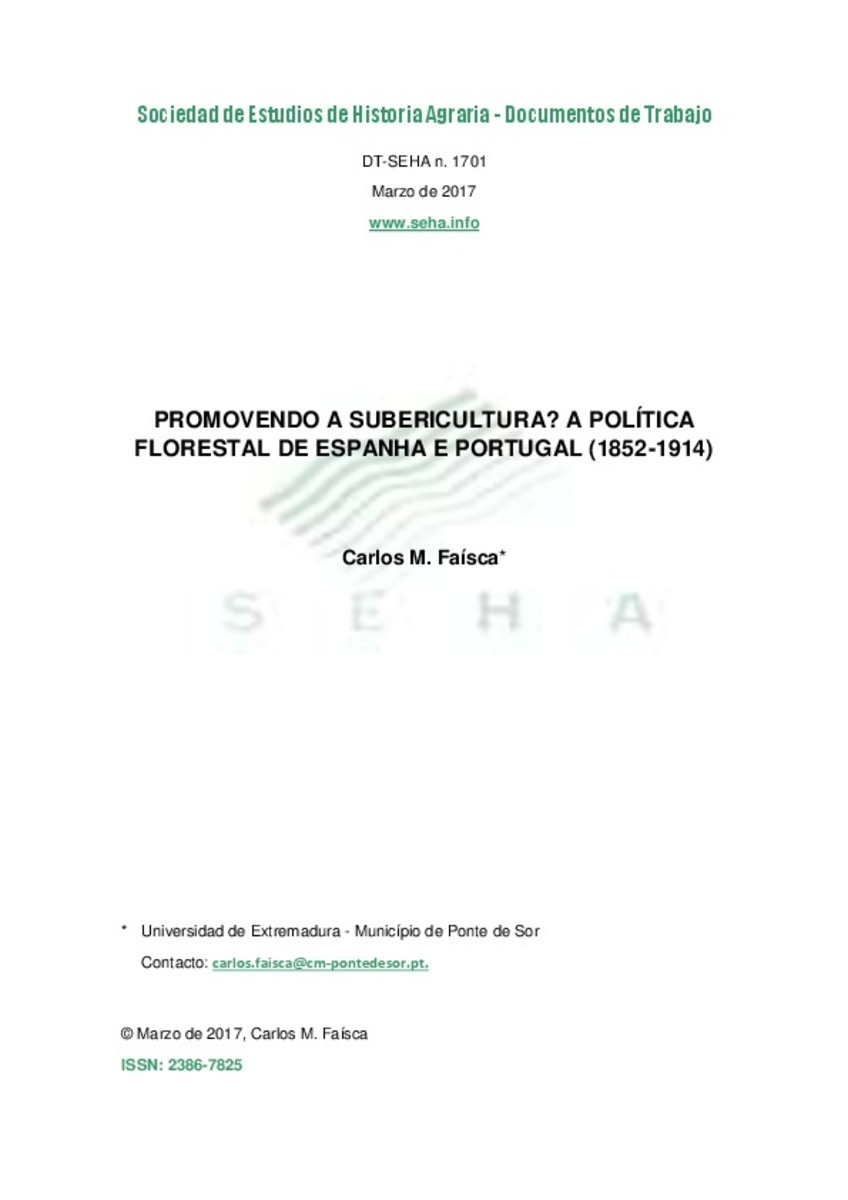Mostrar el registro sencillo del ítem
Promovendo a subericultura? A política florestal de Espanha e Portugal (1852-1914)
| dc.contributor.author | Faísca, Carlos Manuel | |
| dc.date.accessioned | 2017-03-29T12:30:19Z | |
| dc.date.available | 2017-03-29T12:30:19Z | |
| dc.date.issued | 2017-03 | |
| dc.identifier.issn | 2386-7825 | |
| dc.identifier.uri | http://hdl.handle.net/10234/166991 | |
| dc.description.abstract | Atualmente Portugal lidera, a nível mundial, todas as facetas do negócio corticeiro, cenário a que não é alheio o facto de ser neste território que o sobreiro encontra as melhores condições ecológicas para o seu desenvolvimento. Porém, até aos anos 30 do século XX, este papel foi desempenhado por outros países, sobretudo Espanha, sendo que importa isolar os fatores que contribuíram para esta situação. A historiografia tem dado destaque às políticas públicas seguidas por Portugal durante o Estado Novo, por comparação com as executadas pelo franquismo, como um dos principais catalisadores da ascensão do setor corticeiro luso, nas quais se inclui a política florestal. Neste sentido, torna-se imperativo realizar um exercício semelhante para a cronologia em causa, propondo-se este trabalho analisar, em perspetiva comparada, as políticas florestais e cerealíferas oitocentistas de Portugal e Espanha, no último caso devido às implicações que o protecionismo cerealífero teve para com as áreas povoadas com sobreiro. Utilizaram-se, essencialmente, fontes legislativas, relatórios técnicos e estatísticas agrícolas oficiais, tendo-se concluído que não houve uma vantagem clara decorrente de qualquer política pública agroflorestal, por parte do setor corticeiro espanhol sobre o seu congénere português. Na realidade, como iremos demonstrar, a atuação de ambos os Estados nestes aspetos pautou-se muito mais por semelhanças do que por diferenças. | ca_CA |
| dc.description.abstract | Portugal currently leads worldwide all the facets of the cork business, from the forest market, through manufacturing and the trade of cork products. This scenario is enhanced with the fact that in Portugal the cork oak trees have the best conditions for their development. However, up to 1930s, this role was played by other countries, especially by Spain, and is important to understand the factors that contributed to this situation. Recent historiography has highlighted the public policies pursued by Portugal during the Estado Novo, in comparison with those followed by the Franco regime, as one of the main reasons for the rise of the portuguese cork sector, which includes forestry policy. Therefore, it’s important to carry out a similar exercise for the chronology in question, thus the aim of this work is to analyze, in a comparative perspective, the nineteenth-century forest and cereal policies of Portugal and Spain, in the latter case due to the implications that cereal protectionism had towards the cork oak forests. Legislative sources, technical reports and official agricultural statistics were used, and it was concluded that there was no clear advantage derived from any agroforestry public policy by the spanish cork industry compared to the portuguese one. In the matter of fact, as we will demonstrate, both States procedured with great similarity. | ca_CA |
| dc.format.extent | 32 p. | ca_CA |
| dc.format.mimetype | application/pdf | ca_CA |
| dc.language.iso | por | ca_CA |
| dc.publisher | Sociedad Española de Historia Agraria | ca_CA |
| dc.relation.isPartOfSeries | Documentos de Trabajo; 17-01 | |
| dc.rights | © Marzo de 2017, Carlos M. Faísca | ca_CA |
| dc.rights.uri | http://rightsstatements.org/vocab/InC/1.0/ | * |
| dc.subject | Península Ibérica | ca_CA |
| dc.subject | política florestal | ca_CA |
| dc.subject | política cerealífera | ca_CA |
| dc.subject | produção de cortiça | ca_CA |
| dc.subject | indústria corticeira | ca_CA |
| dc.subject | Iberian Peninsula | ca_CA |
| dc.subject | forestry policy | ca_CA |
| dc.subject | cereal policy | ca_CA |
| dc.subject | cork production | ca_CA |
| dc.title | Promovendo a subericultura? A política florestal de Espanha e Portugal (1852-1914) | ca_CA |
| dc.type | info:eu-repo/semantics/workingPaper | ca_CA |
| dc.subject.jel | Q23 | ca_CA |
| dc.subject.jel | Q18 | ca_CA |
| dc.subject.jel | N50 | ca_CA |
| dc.subject.jel | N53 | ca_CA |
| dc.rights.accessRights | info:eu-repo/semantics/openAccess | ca_CA |
Ficheros en el ítem
Este ítem aparece en la(s) siguiente(s) colección(ones)
-
DT_SEHA [101]
Documentos de Trabajo de SEHA







